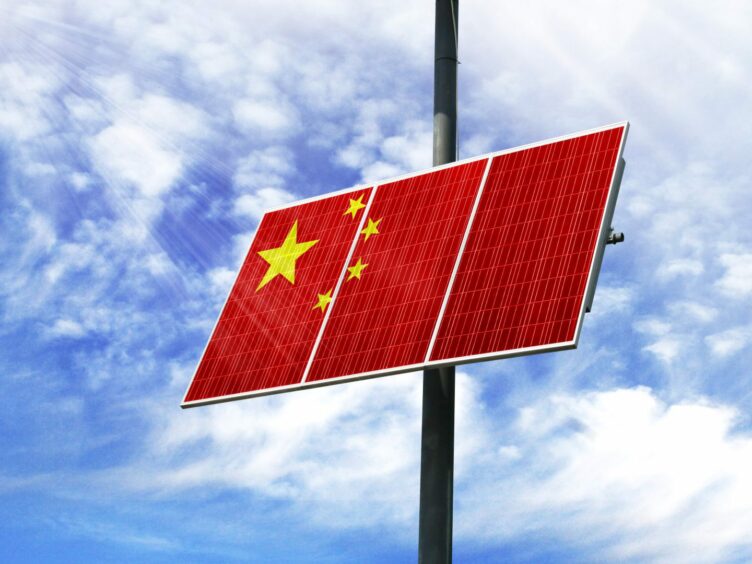
China is continuing its rapid expansion into global new energy markets with exports of solar PV, wind turbines, and energy storage equipment, expected to be worth $100 billion this year, data from energy research firm Wood Mackenzie showed.
Nearly 90% of Li-ion batteries and two thirds of solar module manufacturing capacity are in China along with vast ecosystems of people, industrial parks, materials supply, and logistics.
Indeed, there is a very bright future for renewable energy exports from China given the country’s huge domestic market scale, coupled with improving technology, as well as competitive energy and labour costs, delegates at the Wood Mackenzie’s Power and Renewables Conference APAC heard on Wednesday.
Still, US and Western policy makers remain concerned about their countries reliance on China’s supply chain for new energy technology. China’s share of global manufacturing capacity stands at 50% for wind turbines, 66% for solar modules, and 88% for battery storage, according to data from Wood Mackenzie.
Most of the wind turbine production capacity serves domestic demand as China’s technology is lagging Western peers, but overseas orders are starting to rise with a backlog of 11GW as of June, said analysts at the company. Conversely, much of China’s solar module and battery storage production is exported.
“Foreign countries are facing a tough choice between lower cost exports from China and trying to onshore renewable energy manufacturing in their own markets,” said Alex Whitworth, head of Asia Pacific power and renewables research at the firm.
However, surging inflation in the US is putting pressure on the Biden administration to rethink additional tariffs on Chinese imports and this will probably benefit China, noted Wood Mackenzie.
The US has also given an exemption for solar tariffs on imports from Vietnam, where many Chinese investors have invested in module manufacturing. Therefore, this will, to some extent, benefit China’s solar makers, said Yanting Zhou, principal economist, APAC, at Wood Mackenzie.
Wind, solar and storage equipment costs in China have remained among the lowest in the world, as technology and scale advantages are increasing, helped by a large domestic market.
Surging Power Demand and World’s Biggest Renewable Energy Market
China’s power demand continues to lead that of Asia Pacific and the world. China contributed to 56% of global demand growth since 2000 and now makes up 30% of the global market. It remains the world’s largest market for renewable energy.
Despite severe lockdowns in Q2, power demand growth recovered to hit 2.9% in H1, with high-tech and new energy offsetting traditional sectors, such as steel, cement, and construction materials, reflecting the slowdown in property markets.
China’s power demand growth is expected to rise at a rate of 5% this year on the back of booming exports and high temperatures, reported Wood Mackenzie.
The renewable energy market has put in an outstanding performance over the past six months, despite Covid lockdowns since April, noted analysts at the firm. Wind and solar additions are expected to hit 127GW in 2022, up around 25% year-on-year. Cumulative wind and solar capacity stand at 780GW.
However, the solar supply chain is facing some challenges, particularly the rising cost of raw materials, such as silicone. The new order backlog for solar fell in June as the price of solar modules increases and this might hit demand, warned Wood Mackenzie.
The solar supply chain in China remains centralised and this gives the raw material suppliers strong bargaining power. But the central government is investigating the rise in silicone pricing, which is up three times since early 2021, and could potentially intervene.
Conversely, the price of wind turbines remain relatively stable as the supply chain is more competitive affording the OEM’s more bargaining power.
Energy Security Driving Renewable Energy in China
Energy security is driving the uptake of renewable energy in China to reduce its reliance on imported fuel. Some 30% of power supply comes from renewable energy, including hydro, and another 5% comes from nuclear, noted Whitworth. The use of electric vehicles is also on the rise with 20% of new vehicles powered by electricity. As a result, crude oil imports are down 11%, he added.
China is also witnessing a massive increase in coal production, up 11% year-on-year in H1 2022.
“China is the only country in the world where you can read in the newspaper that 1.4GW of renewable energy has been permitted, 2GW of coal power has been approved, as well as a 50 million tons coal mine,” said Whitworth.
“The government is pulling out all the stops to keep energy costs down and its industry competitive, while aiming to hit peak emissions by 2030 and carbon neutrality by 2050,” he added.
Delegates at the conference heard on Tuesday that the research firm sees coal-fired power playing a major role in Asia’s energy transition towards renewable energy, particularly in China and India. “This could be the big trend in coming years,” said Whitworth.
Recommended for you

